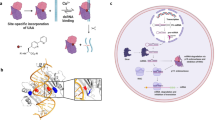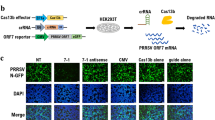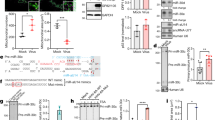Abstract
Many microRNAs (miRNAs) are encoded within the introns of RNA Pol II transcripts, often as polycistronic precursors. Here, we demonstrate the optimization of an intron encoding three endogenous miRNAs for the ectopic expression of heterologous anti-HIV-1 small interfering RNAs (siRNAs) processed from a single RNA polymerase II primary miRNA. Our expression system, designated as MCM7, is engineered from the intron-embedded, tri-cistronic miR-106b cluster that endogenously expresses miR-106b, miR-93 and miR-25. Manipulation of the miR-106b cluster demonstrated a strict requirement for maintenance of the native flanking primary miRNA (pri-miRNA) sequences and key structural features of the native miRNAs for efficient siRNA processing. As a model for testing the efficacy of this approach, we have replaced the three endogenous miRNAs with siRNAs targeting the tat and rev transcripts of human immunodeficiency virus type 1 (HIV-1). This study has enabled us to establish guidelines for optimal processing of the engineered miRNA mimics into functional siRNAs. In addition, we demonstrate that the incorporation of a small nucleolar RNA TAR chimeric decoy (snoRNA) inserted within the MCM7 intron resulted in a substantial enhancement of HIV suppression in long-term acute infectious HIV-1 challenges.
This is a preview of subscription content, access via your institution
Access options
Subscribe to this journal
Receive 12 print issues and online access
$259.00 per year
only $21.58 per issue
Buy this article
- Purchase on SpringerLink
- Instant access to full article PDF
Prices may be subject to local taxes which are calculated during checkout









Similar content being viewed by others
References
Fire A, Xu S, Montgomery MK, Kostas SA, Driver SE, Mello CC . Potent and specific genetic interference by double-stranded RNA in Caenorhabditis elegans. Nature 1998; 391: 806–811.
Elbashir SM, Harborth J, Lendeckel W, Yalcin A, Weber K, Tuschl T . Duplexes of 21-nucleotide RNAs mediate RNA interference in cultured mammalian cells. Nature 2001; 411: 494–498.
Hannon GJ, Rossi JJ . Unlocking the potential of the human genome with RNA interference. Nature 2004; 431: 371–378.
Dykxhoorn DM, Lieberman J . Silencing viral infection. PLoS Med 2006; 3: e242.
Kim DH, Rossi JJ . Strategies for silencing human disease using RNA interference. Nat Rev Genet 2007; 8: 173–184.
Brummelkamp TR, Bernards R, Agami R . A system for stable expression of short interfering RNAs in mammalian cells. Science 2002; 296: 550–553.
Paddison PJ, Caudy AA, Bernstein E, Hannon GJ, Conklin DS . Short hairpin RNAs (shRNAs) induce sequence-specific silencing in mammalian cells. Genes Dev 2002; 16: 948–958.
Zeng Y, Wagner EJ, Cullen BR . Both natural and designed micro RNAs can inhibit the expression of cognate mRNAs when expressed in human cells. Mol Cell 2002; 9: 1327–1333.
Bartel DP, Chen CZ . Micromanagers of gene expression: the potentially widespread influence of metazoan microRNAs. Nat Rev Genet 2004; 5: 396–400.
Gitlin L, Karelsky S, Andino R . Short interfering RNA confers intracellular antiviral immunity in human cells. Nature 2002; 418: 430–434.
Lee NS, Dohjima T, Bauer G, Li H, Li MJ, Ehsani A et al. Expression of small interfering RNAs targeted against HIV-1 rev transcripts in human cells. Nat Biotechnol 2002; 20: 500–505.
Li MJ, Bauer G, Michienzi A, Yee JK, Lee NS, Kim J et al. Inhibition of HIV-1 infection by lentiviral vectors expressing Pol III-promoted anti-HIV RNAs. Mol Ther 2003; 8: 196–206.
Rubinson DA, Dillon CP, Kwiatkowski AV, Sievers C, Yang L, Kopinja J et al. A lentivirus-based system to functionally silence genes in primary mammalian cells, stem cells and transgenic mice by RNA interference. Nat Genet 2003; 33: 401–406.
Snove Jr O, Rossi JJ . Expressing short hairpin RNAs in vivo. Nat Methods 2006; 3: 689–695.
Grimm D, Kay MA . Combinatorial RNAi: a winning strategy for the race against evolving targets? Mol Ther 2007; 15: 878–888.
Boden D, Pusch O, Lee F, Tucker L, Ramratnam B . Human immunodeficiency virus type 1 escape from RNA interference. J Virol 2003; 77: 11531–11535.
Das AT, Brummelkamp TR, Westerhout EM, Vink M, Madiredjo M, Bernards R et al. Human immunodeficiency virus type 1 escapes from RNA interference-mediated inhibition. J Virol 2004; 78: 2601–2605.
Westerhout EM, Ooms M, Vink M, Das AT, Berkhout B . HIV-1 can escape from RNA interference by evolving an alternative structure in its RNA genome. Nucleic Acids Res 2005; 33: 796–804.
Wilson JA, Richardson CD . Hepatitis C virus replicons escape RNA interference induced by a short interfering RNA directed against the NS5b coding region. J Virol 2005; 79: 7050–7058.
von Eije KJ, ter Brake O, Berkhout B . Human immunodeficiency virus type 1 escape is restricted when conserved genome sequences are targeted by RNA interference. J Virol 2008; 82: 2895–2903.
Song E, Lee SK, Dykxhoorn DM, Novina C, Zhang D, Crawford K et al. Sustained small interfering RNA-mediated human immunodeficiency virus type 1 inhibition in primary macrophages. J Virol 2003; 77: 7174–7181.
Andersson MG, Haasnoot PC, Xu N, Berenjian S, Berkhout B, Akusjärvi G . Suppression of RNA interference by adenovirus virus-associated RNA. J Virol 2005; 79: 9556–9565.
Chang LJ, Liu X, He J . Lentiviral siRNAs targeting multiple highly conserved RNA sequences of human immunodeficiency virus type 1. Gene Therapy 2005; 12: 1133–1144.
Henry SD, van der Wegen P, Metselaar HJ, Tilanus HW, Scholte BJ, van der Laan LJ . Simultaneous targeting of HCV replication and viral binding with a single lentiviral vector containing multiple RNA interference expression cassettes. Mol Ther 2006; 14: 485–493.
Li M, Rossi JJ . Lentiviral vector delivery of siRNA and shRNA encoding genes into cultured and primary hematopoietic cells. Methods Mol Biol 2005; 309: 261–272.
ter Brake O, Konstantinova P, Ceylan M, Berkhout B . Silencing of HIV-1 with RNA interference: a multiple shRNA approach. Mol Ther 2006; 14: 883–892.
ter Brake O, ‘t Hooft K, Liu YP, Centlivre M, von Eije KJ, Berkhout B . Lentiviral vector design for multiple shRNA expression and durable HIV-1 inhibition. Mol Ther 2008; 16: 557–564.
Leonard JN, Schaffer DV . Computational design of antiviral RNA interference strategies that resist human immunodeficiency virus escape. J Virol 2005; 79: 1645–1654.
An DS, Qin FX, Auyeung VC, Mao SH, Kung SK, Baltimore D et al. Optimization and functional effects of stable short hairpin RNA expression in primary human lymphocytes via lentiviral vectors. Mol Ther 2006; 14: 494–504.
Grimm D, Streetz KL, Jopling CL, Storm TA, Pandey K, Davis CR et al. Fatality in mice due to oversaturation of cellular microRNA/short hairpin RNA pathways. Nature 2006; 441: 537–541.
Bartel DP . MicroRNAs: genomics, biogenesis, mechanism, and function. Cell 2004; 116: 281–297.
Kim VN . MicroRNA biogenesis: coordinated cropping and dicing. Nat Rev Mol Cell Biol 2005; 6: 376–385.
Kim VN . Small RNAs: classification, biogenesis, and function. Mol Cells 2005; 19: 1–15.
Mourelatos Z, Dostie J, Paushkin S, Sharma A, Charroux B, Abel L et al. miRNPs: a novel class of ribonucleoproteins containing numerous microRNAs. Genes Dev 2002; 16: 720–728.
Cai X, Hagedorn CH, Cullen BR . Human microRNAs are processed from capped, polyadenylated transcripts that can also function as mRNAs. RNA 2004; 10: 1957–1966.
Lee Y, Kim M, Han J, Yeom KH, Lee S, Baek SH et al. MicroRNA genes are transcribed by RNA polymerase II. EMBO J 2004; 23: 4051–4060.
Denli AM, Tops BB, Plasterk RH, Ketting RF, Hannon GJ . Processing of primary microRNAs by the Microprocessor complex. Nature 2004; 432: 231–235.
Gregory RI, Yan KP, Amuthan G, Chendrimada T, Doratotaj B, Cooch N et al. The microprocessor complex mediates the genesis of microRNAs. Nature 2004; 432: 235–240.
Han J, Lee Y, Yeom KH, Kim YK, Jin H, Kim VN . The Drosha–DGCR8 complex in primary microRNA processing. Genes Dev 2004; 18: 3016–3027.
Landthaler M, Yalcin A, Tuschl T . The human DiGeorge syndrome critical region gene 8 and its D. melanogaster homolog are required for miRNA biogenesis. Curr Biol 2004; 14: 2162–2167.
Lee Y, Ahn C, Han J, Choi H, Kim J, Yim J et al. The nuclear RNase III Drosha initiates microRNA processing. Nature 2003; 425: 415–419.
Lund E, Guttinger S, Calado A, Dahlberg JE, Kutay U . Nuclear export of microRNA precursors. Science 2004; 303: 95–98.
Yi R, Qin Y, Macara IG, Cullen BR . Exportin-5 mediates the nuclear export of pre-microRNAs and short hairpin RNAs. Genes Dev 2003; 17: 3011–3016.
Zeng Y, Cullen BR . Structural requirements for pre-microRNA binding and nuclear export by Exportin 5. Nucleic Acids Res 2004; 32: 4776–4785.
Chendrimada TP, Gregory RI, Kumaraswamy E, Norman J, Cooch N, Nishikura K et al. TRBP recruits the Dicer complex to Ago2 for microRNA processing and gene silencing. Nature 2005; 436: 740–744.
Gregory RI, Chendrimada TP, Cooch N, Shiekhattar R . Human RISC couples microRNA biogenesis and posttranscriptional gene silencing. Cell 2005; 123: 631–640.
Lee Y, Jeon K, Lee JT, Kim S, Kim VN . MicroRNA maturation: stepwise processing and subcellular localization. EMBO J 2002; 21: 4663–4670.
Altuvia Y, Landgraf P, Lithwick G, Elefant N, Pfeffer S, Aravin A et al. Clustering and conservation patterns of human microRNAs. Nucleic Acids Res 2005; 33: 2697–2706.
He L, Thomson JM, Hemann MT, Hernando-Monge E, Mu D, Goodson S et al. A microRNA polycistron as a potential human oncogene. Nature 2005; 435: 828–833.
Tanzer A, Stadler PF . Molecular evolution of a microRNA cluster. J Mol Biol 2004; 339: 327–335.
Kim YK, Kim VN . Processing of intronic microRNAs. EMBO J 2007; 26: 775–783.
Rodriguez A, Griffiths-Jones S, Ashurst JL, Bradley A . Identification of mammalian microRNA host genes and transcription units. Genome Res 2004; 14: 1902–1910.
Chang K, Elledge SJ, Hannon GJ . Lessons from Nature: microRNA-based shRNA libraries. Nat Methods 2006; 3: 707–714.
Silva JM, Li MZ, Chang K, Ge W, Golding MC, Rickles RJ et al. Second-generation shRNA libraries covering the mouse and human genomes. Nat Genet 2005; 37: 1281–1288.
Stegmeier F, Hu G, Rickles RJ, Hannon GJ, Elledge SJ . A lentiviral microRNA-based system for single-copy polymerase II-regulated RNA interference in mammalian cells. Proc Natl Acad Sci USA 2005; 102: 13212–13217.
Dickins RA, Hemann MT, Zilfou JT, Simpson DR, Ibarra I, Hannon GJ et al. Probing tumor phenotypes using stable and regulated synthetic microRNA precursors. Nat Genet 2005; 37: 1289–1295.
Zhou H, Xia XG, Xu Z . An RNA polymerase II construct synthesizes short-hairpin RNA with a quantitative indicator and mediates highly efficient RNAi. Nucleic Acids Res 2005; 33: e62.
Chung KH, Hart CC, Al-Bassam S, Avery A, Taylor J, Patel PD et al. Polycistronic RNA polymerase II expression vectors for RNA interference based on BIC/miR-155. Nucleic Acids Res 2006; 34: e53.
Du G, Yonekubo J, Zeng Y, Osisami M, Frohman MA . Design of expression vectors for RNA interference based on miRNAs and RNA splicing. FEBS J 2006; 273: 5421–5427.
Han J, Lee Y, Yeom KH, Nam JW, Heo I, Rhee JK et al. Molecular basis for the recognition of primary microRNAs by the Drosha–DGCR8 complex. Cell 2006; 125: 887–901.
Zeng Y, Yi R, Cullen BR . Recognition and cleavage of primary microRNA precursors by the nuclear processing enzyme Drosha. EMBO J 2005; 24: 138–148.
Michienzi A, Li S, Zaia JA, Rossi JJ . A nucleolar TAR decoy inhibitor of HIV-1 replication. Proc Natl Acad Sci USA 2002; 99: 14047–14052.
Tomari Y, Matranga C, Haley B, Martinez N, Zamore PD . A protein sensor for siRNA asymmetry. Science 2004; 306: 1377–1380.
Schwarz DS, Hutvágner G, Du T, Xu Z, Aronin N, Zamore PD . Asymmetry in the assembly of the RNAi enzyme complex. Cell 2003; 115: 199–208.
Hirose T, Shu MD, Steitz JA . Splicing-dependent and -independent modes of assembly for intron-encoded box C/D snoRNPs in mammalian cells. Mol Cell 2003; 12: 113–123.
Hirose T, Steitz JA . Position within the host intron is critical for efficient processing of box C/D snoRNAs in mammalian cells. Proc Natl Acad Sci USA 2001; 98: 12914–12919.
Pumfery A, de la Fuente C, Berro R, Nekhai S, Kashanchi F, Chao SH . Potential use of pharmacological cyclin-dependent kinase inhibitors as anti-HIV therapeutics. Curr Pharm Des 2006; 12: 1949–1961.
Aagaard L, Amarzguioui M, Sun G, Santos LC, Ehsani A, Prydz H et al. A facile lentiviral vector system for expression of doxycycline-inducible shRNAs: knockdown of the pre-miRNA processing enzyme Drosha. Mol Ther 2007; 15: 938–945.
Helvik SA, Snove Jr O, Saetrom P . Reliable prediction of Drosha processing sites improves microRNA gene prediction. Bioinformatics 2007; 23: 142–149.
Khvorova A, Reynolds A, Jayasena SD . Functional siRNAs and miRNAs exhibit strand bias. Cell 2003; 115: 209–216.
Li MJ, Kim J, Li S, Zaia J, Yee JK, Anderson J et al. Long-term inhibition of HIV-1 infection in primary hematopoietic cells by lentiviral vector delivery of a triple combination of anti-HIV shRNA, anti-CCR5 ribozyme, and a nucleolar-localizing TAR decoy. Mol Ther 2005; 12: 900–909.
Unwalla HJ, Li MJ, Kim JD, Li HT, Ehsani A, Alluin J et al. Negative feedback inhibition of HIV-1 by TAT-inducible expression of siRNA. Nat Biotech 2004; 22: 1573–1578.
Acknowledgements
This work was funded by a fellowship to LAA from the Alfred Benzon Foundation, a post-doctoral fellowship to MA from the Norwegian Research Council and NIH AI42552. AI29329 and HL07470 grants to JJR. KJE is supported by ZonMW through a VICI grant. We thank A Ehsani for his suggestions about the positions for inserting the Tar decoy and members of the Rossi lab for their support.
Author information
Authors and Affiliations
Corresponding author
Additional information
The authors declare no competing financial interest.
Supplementary Information accompanies the paper on Gene Therapy website (http://www.nature.com/gt)
Supplementary information
Rights and permissions
About this article
Cite this article
Aagaard, L., Zhang, J., von Eije, K. et al. Engineering and optimization of the miR-106b cluster for ectopic expression of multiplexed anti-HIV RNAs. Gene Ther 15, 1536–1549 (2008). https://doi.org/10.1038/gt.2008.147
Received:
Revised:
Accepted:
Published:
Issue Date:
DOI: https://doi.org/10.1038/gt.2008.147



